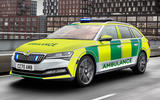Skoda's trio of iV-badged plug-in hybrid models have been made available to emergency services in the UK.
The brand's models are already popular with police, ambulance and fire services across the country, but this is Skoda's "first electrified offering for emergency services".
Each will be equipped with a specially adapted inforainment system and 360deg emergency lighting, and further customisation is available through Skoda's network of approved convertors.
The Octavia vRS iV - Skoda's first electrified performance car - is said to be "ideal for any rapid response unit" with its 0-62mph time of 7.3sec and electric-only range of 39 miles.
Mechanically unaltered over the standard car, the vRS will take its power from a 1.4-litre turbocharged petrol engine and an 85kW electric motor for combined outputs of 242bhp and 295lb ft.
Aside from the requisite blue lights and Battenberg livery, it will be offered with 19in alloy wheels, Matrix LED headlights and a 10in infotainment touchscreen.
The standard Octavia iV will also be enlisted, offering a downtuned variant of the same powertrain with 201bhp and 258lb ft for use by fire responders. Electric range, though, is boosted to 43 miles.
The largest of the three, the Superb iV, packs 215bhp and can travel on electricity for 37 miles. Emergency-spec examples can be had in estate or hatchback form, with the larger said to provide "sufficient room for blue-light customers to store and transport vital life-saving emergency equipment such as oxygen tanks, ventilators and other essential breathing apparatus".
READ MORE
Skoda Octavia iV 2020 UK review













Join the debate
Add your comment
I would imagine that these vehicles wil probably fall into the trap of never being plugged in. Apart from the fact that they are in use for so much of the time (especially so with shift changes), there is the issue of installing chargers at, for example, Police stations. The one where I work has only one dedicated charger, and, as it is a Private Finance Initiative building they are not able to easily get permission to upgrade the electrics and install more.
My wife works at the local police station, they have a fleet of (full EV) i3's for their community work/visiting people to take statements etc which seem to be used alot and are charged without issue. I agree about the normal response vehicles are out in use so much that finding enough downtime to charge them would be difficult and therefore not used.